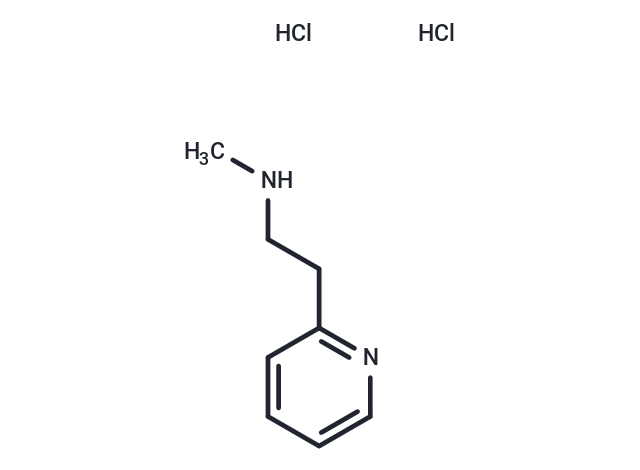Shopping Cart
- Remove All
 Your shopping cart is currently empty
Your shopping cart is currently empty

Betahistine dihydrochloride (Betahistine 2HCl) is a histamine analog and H1 receptor agonist that serves as a vasodilator.

| Pack Size | Price | Availability | Quantity |
|---|---|---|---|
| 1 g | $29 | In Stock | |
| 1 mL x 10 mM (in DMSO) | $29 | In Stock |
| Description | Betahistine dihydrochloride (Betahistine 2HCl) is a histamine analog and H1 receptor agonist that serves as a vasodilator. |
| Targets&IC50 | H3 receptor:1.9 μM |
| In vitro | In mice, Betahistine (ED50=2 mg/kg) elevates t-MeHA levels in a dose-dependent manner. In patients with Ménière's disease, Betahistine (16 mg, twice daily for 3 months) significantly alleviates vertigo. Additionally, Betahistine (50 mg/kg) induces an upregulation of histidine decarboxylase mRNA in the nodose ganglion of the cat brain. |
| In vivo | In CHO(H3R) cells treated with 3 μM of, Betahistine progressively increased cAMP formation, peaking at 10 nM. Furthermore, in CHO(H3R) cells, Betahistine progressively reduced A23187-induced [3H]arachidonic acid release (EC50=0.1 nM), with the greatest effect observed at 30 nM. |
| Alias | PT-9, Betahistine 2HCl |
| Molecular Weight | 209.12 |
| Formula | C8H14Cl2N2 |
| Cas No. | 5579-84-0 |
| Smiles | Cl.Cl.CNCCC1=NC=CC=C1 |
| Relative Density. | 0.967 g/cm3 |
| Storage | keep away from moisture | Powder: -20°C for 3 years | In solvent: -80°C for 1 year | Shipping with blue ice. | ||||||||||||||||||||||||||||||||||||||||
| Solubility Information | DMSO: 50 mg/mL (239.1 mM), Sonication is recommended. H2O: 35 mg/mL (167.37 mM), Sonication is recommended. Ethanol: 1 mg/mL (4.78 mM), Sonication is recommended. | ||||||||||||||||||||||||||||||||||||||||
Solution Preparation Table | |||||||||||||||||||||||||||||||||||||||||
Ethanol/H2O/DMSO
H2O/DMSO
| |||||||||||||||||||||||||||||||||||||||||

Copyright © 2015-2025 TargetMol Chemicals Inc. All Rights Reserved.